Developing Enterprise: Case study on TATA MOTORS
VerifiedAdded on 2023/04/22
|12
|3968
|465
AI Summary
This case study focuses on enterprise development and provides principles and practices of strategic enterprise management and new venture entrepreneurship. It also explains finance and investment models, skills in communicating entrepreneurial planning and decision-making, impact of market on business’s objectives, and enterprise tools and theories in business environment. The document type is a case study and the type of assignment is not mentioned. The subject is not mentioned, but the course code, course name, and college/university are not mentioned either.
Contribute Materials
Your contribution can guide someone’s learning journey. Share your
documents today.
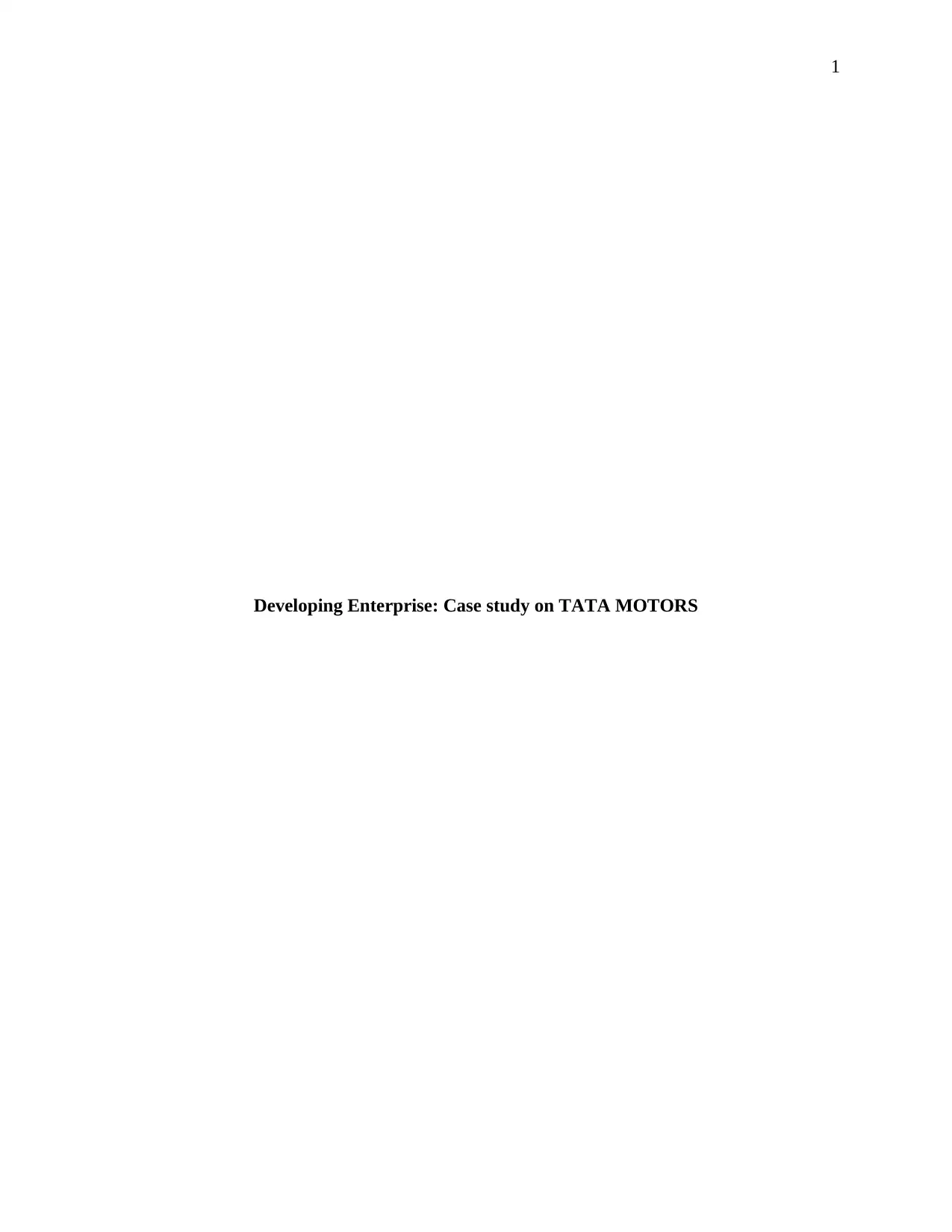
1
Developing Enterprise: Case study on TATA MOTORS
Developing Enterprise: Case study on TATA MOTORS
Secure Best Marks with AI Grader
Need help grading? Try our AI Grader for instant feedback on your assignments.
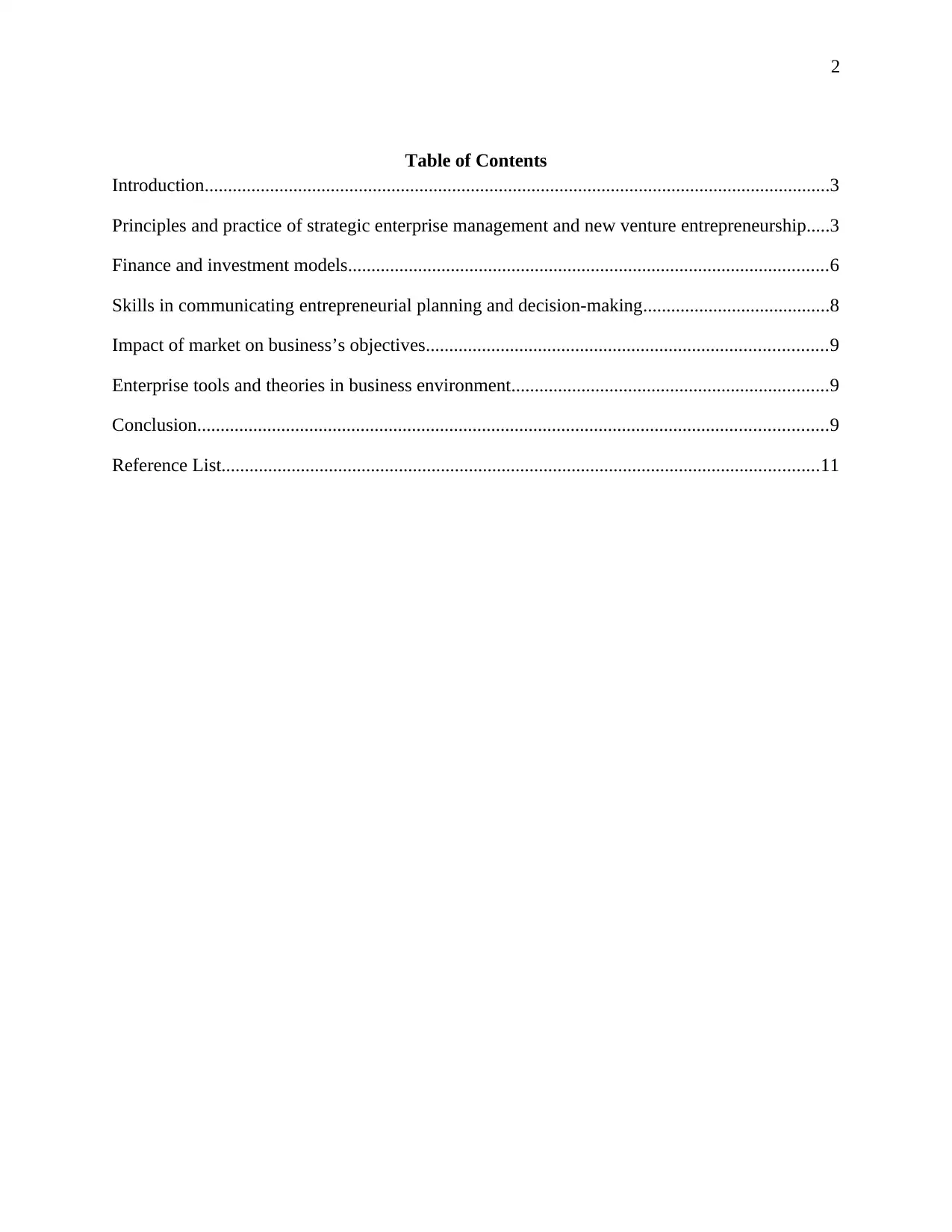
2
Table of Contents
Introduction......................................................................................................................................3
Principles and practice of strategic enterprise management and new venture entrepreneurship.....3
Finance and investment models.......................................................................................................6
Skills in communicating entrepreneurial planning and decision-making........................................8
Impact of market on business’s objectives......................................................................................9
Enterprise tools and theories in business environment....................................................................9
Conclusion.......................................................................................................................................9
Reference List................................................................................................................................11
Table of Contents
Introduction......................................................................................................................................3
Principles and practice of strategic enterprise management and new venture entrepreneurship.....3
Finance and investment models.......................................................................................................6
Skills in communicating entrepreneurial planning and decision-making........................................8
Impact of market on business’s objectives......................................................................................9
Enterprise tools and theories in business environment....................................................................9
Conclusion.......................................................................................................................................9
Reference List................................................................................................................................11
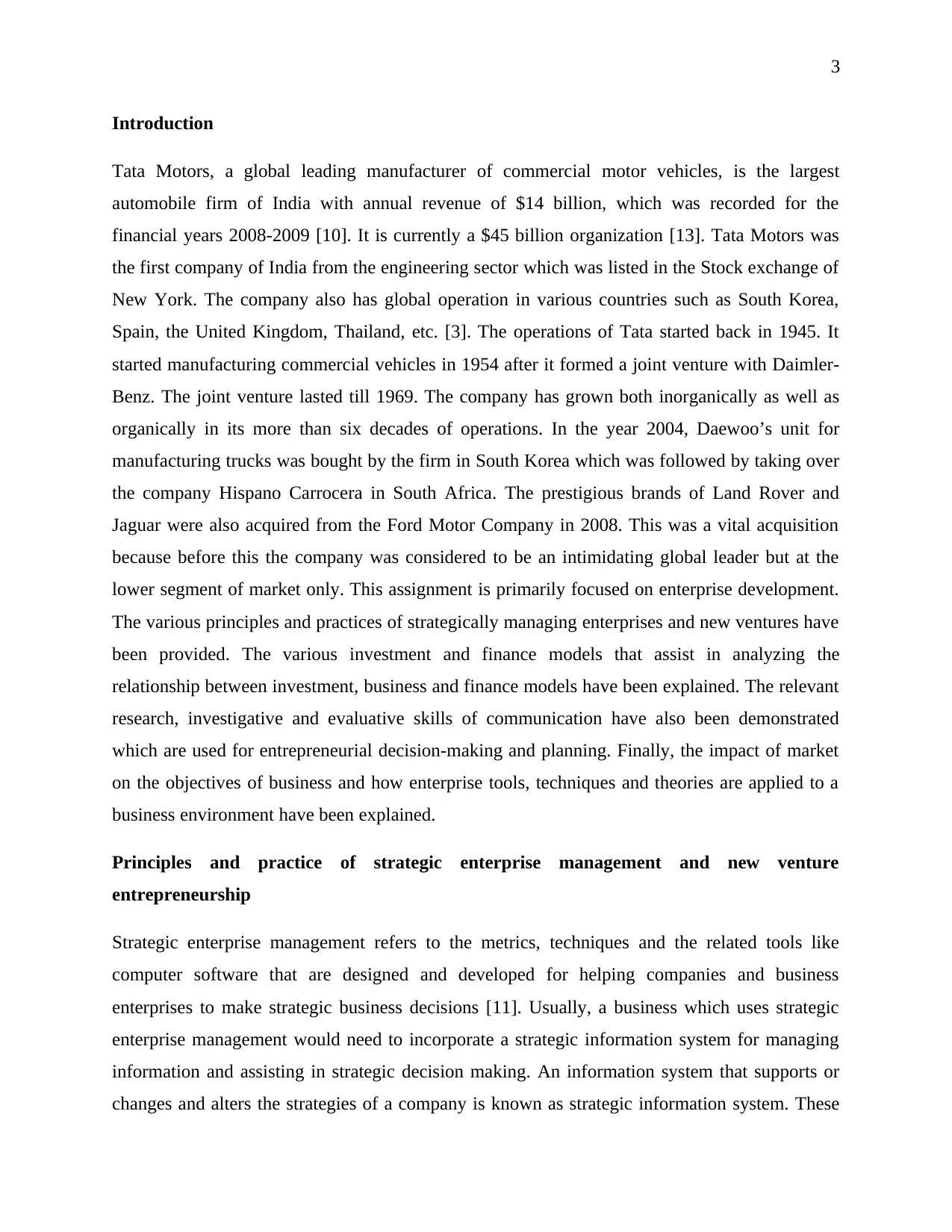
3
Introduction
Tata Motors, a global leading manufacturer of commercial motor vehicles, is the largest
automobile firm of India with annual revenue of $14 billion, which was recorded for the
financial years 2008-2009 [10]. It is currently a $45 billion organization [13]. Tata Motors was
the first company of India from the engineering sector which was listed in the Stock exchange of
New York. The company also has global operation in various countries such as South Korea,
Spain, the United Kingdom, Thailand, etc. [3]. The operations of Tata started back in 1945. It
started manufacturing commercial vehicles in 1954 after it formed a joint venture with Daimler-
Benz. The joint venture lasted till 1969. The company has grown both inorganically as well as
organically in its more than six decades of operations. In the year 2004, Daewoo’s unit for
manufacturing trucks was bought by the firm in South Korea which was followed by taking over
the company Hispano Carrocera in South Africa. The prestigious brands of Land Rover and
Jaguar were also acquired from the Ford Motor Company in 2008. This was a vital acquisition
because before this the company was considered to be an intimidating global leader but at the
lower segment of market only. This assignment is primarily focused on enterprise development.
The various principles and practices of strategically managing enterprises and new ventures have
been provided. The various investment and finance models that assist in analyzing the
relationship between investment, business and finance models have been explained. The relevant
research, investigative and evaluative skills of communication have also been demonstrated
which are used for entrepreneurial decision-making and planning. Finally, the impact of market
on the objectives of business and how enterprise tools, techniques and theories are applied to a
business environment have been explained.
Principles and practice of strategic enterprise management and new venture
entrepreneurship
Strategic enterprise management refers to the metrics, techniques and the related tools like
computer software that are designed and developed for helping companies and business
enterprises to make strategic business decisions [11]. Usually, a business which uses strategic
enterprise management would need to incorporate a strategic information system for managing
information and assisting in strategic decision making. An information system that supports or
changes and alters the strategies of a company is known as strategic information system. These
Introduction
Tata Motors, a global leading manufacturer of commercial motor vehicles, is the largest
automobile firm of India with annual revenue of $14 billion, which was recorded for the
financial years 2008-2009 [10]. It is currently a $45 billion organization [13]. Tata Motors was
the first company of India from the engineering sector which was listed in the Stock exchange of
New York. The company also has global operation in various countries such as South Korea,
Spain, the United Kingdom, Thailand, etc. [3]. The operations of Tata started back in 1945. It
started manufacturing commercial vehicles in 1954 after it formed a joint venture with Daimler-
Benz. The joint venture lasted till 1969. The company has grown both inorganically as well as
organically in its more than six decades of operations. In the year 2004, Daewoo’s unit for
manufacturing trucks was bought by the firm in South Korea which was followed by taking over
the company Hispano Carrocera in South Africa. The prestigious brands of Land Rover and
Jaguar were also acquired from the Ford Motor Company in 2008. This was a vital acquisition
because before this the company was considered to be an intimidating global leader but at the
lower segment of market only. This assignment is primarily focused on enterprise development.
The various principles and practices of strategically managing enterprises and new ventures have
been provided. The various investment and finance models that assist in analyzing the
relationship between investment, business and finance models have been explained. The relevant
research, investigative and evaluative skills of communication have also been demonstrated
which are used for entrepreneurial decision-making and planning. Finally, the impact of market
on the objectives of business and how enterprise tools, techniques and theories are applied to a
business environment have been explained.
Principles and practice of strategic enterprise management and new venture
entrepreneurship
Strategic enterprise management refers to the metrics, techniques and the related tools like
computer software that are designed and developed for helping companies and business
enterprises to make strategic business decisions [11]. Usually, a business which uses strategic
enterprise management would need to incorporate a strategic information system for managing
information and assisting in strategic decision making. An information system that supports or
changes and alters the strategies of a company is known as strategic information system. These
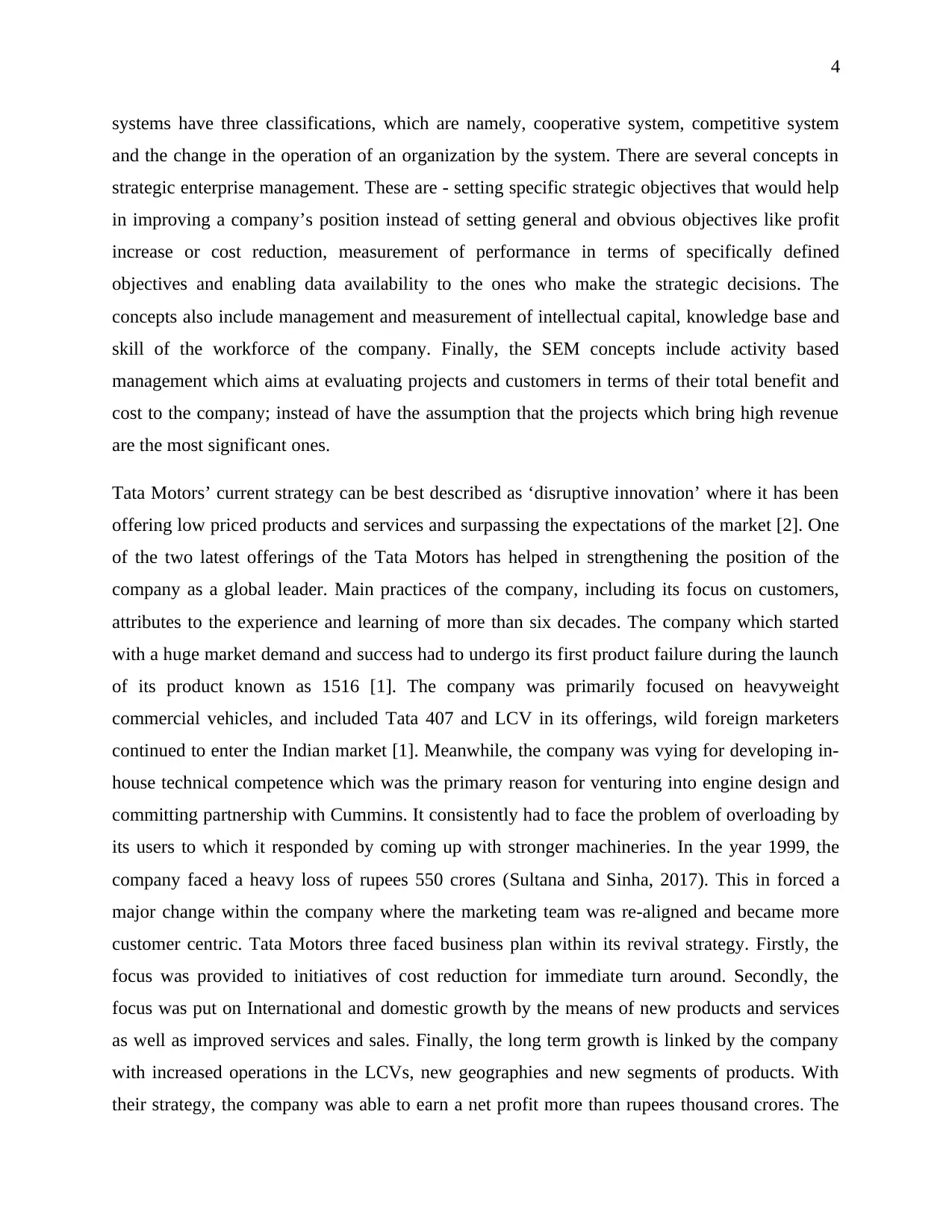
4
systems have three classifications, which are namely, cooperative system, competitive system
and the change in the operation of an organization by the system. There are several concepts in
strategic enterprise management. These are - setting specific strategic objectives that would help
in improving a company’s position instead of setting general and obvious objectives like profit
increase or cost reduction, measurement of performance in terms of specifically defined
objectives and enabling data availability to the ones who make the strategic decisions. The
concepts also include management and measurement of intellectual capital, knowledge base and
skill of the workforce of the company. Finally, the SEM concepts include activity based
management which aims at evaluating projects and customers in terms of their total benefit and
cost to the company; instead of have the assumption that the projects which bring high revenue
are the most significant ones.
Tata Motors’ current strategy can be best described as ‘disruptive innovation’ where it has been
offering low priced products and services and surpassing the expectations of the market [2]. One
of the two latest offerings of the Tata Motors has helped in strengthening the position of the
company as a global leader. Main practices of the company, including its focus on customers,
attributes to the experience and learning of more than six decades. The company which started
with a huge market demand and success had to undergo its first product failure during the launch
of its product known as 1516 [1]. The company was primarily focused on heavyweight
commercial vehicles, and included Tata 407 and LCV in its offerings, wild foreign marketers
continued to enter the Indian market [1]. Meanwhile, the company was vying for developing in-
house technical competence which was the primary reason for venturing into engine design and
committing partnership with Cummins. It consistently had to face the problem of overloading by
its users to which it responded by coming up with stronger machineries. In the year 1999, the
company faced a heavy loss of rupees 550 crores (Sultana and Sinha, 2017). This in forced a
major change within the company where the marketing team was re-aligned and became more
customer centric. Tata Motors three faced business plan within its revival strategy. Firstly, the
focus was provided to initiatives of cost reduction for immediate turn around. Secondly, the
focus was put on International and domestic growth by the means of new products and services
as well as improved services and sales. Finally, the long term growth is linked by the company
with increased operations in the LCVs, new geographies and new segments of products. With
their strategy, the company was able to earn a net profit more than rupees thousand crores. The
systems have three classifications, which are namely, cooperative system, competitive system
and the change in the operation of an organization by the system. There are several concepts in
strategic enterprise management. These are - setting specific strategic objectives that would help
in improving a company’s position instead of setting general and obvious objectives like profit
increase or cost reduction, measurement of performance in terms of specifically defined
objectives and enabling data availability to the ones who make the strategic decisions. The
concepts also include management and measurement of intellectual capital, knowledge base and
skill of the workforce of the company. Finally, the SEM concepts include activity based
management which aims at evaluating projects and customers in terms of their total benefit and
cost to the company; instead of have the assumption that the projects which bring high revenue
are the most significant ones.
Tata Motors’ current strategy can be best described as ‘disruptive innovation’ where it has been
offering low priced products and services and surpassing the expectations of the market [2]. One
of the two latest offerings of the Tata Motors has helped in strengthening the position of the
company as a global leader. Main practices of the company, including its focus on customers,
attributes to the experience and learning of more than six decades. The company which started
with a huge market demand and success had to undergo its first product failure during the launch
of its product known as 1516 [1]. The company was primarily focused on heavyweight
commercial vehicles, and included Tata 407 and LCV in its offerings, wild foreign marketers
continued to enter the Indian market [1]. Meanwhile, the company was vying for developing in-
house technical competence which was the primary reason for venturing into engine design and
committing partnership with Cummins. It consistently had to face the problem of overloading by
its users to which it responded by coming up with stronger machineries. In the year 1999, the
company faced a heavy loss of rupees 550 crores (Sultana and Sinha, 2017). This in forced a
major change within the company where the marketing team was re-aligned and became more
customer centric. Tata Motors three faced business plan within its revival strategy. Firstly, the
focus was provided to initiatives of cost reduction for immediate turn around. Secondly, the
focus was put on International and domestic growth by the means of new products and services
as well as improved services and sales. Finally, the long term growth is linked by the company
with increased operations in the LCVs, new geographies and new segments of products. With
their strategy, the company was able to earn a net profit more than rupees thousand crores. The
Secure Best Marks with AI Grader
Need help grading? Try our AI Grader for instant feedback on your assignments.
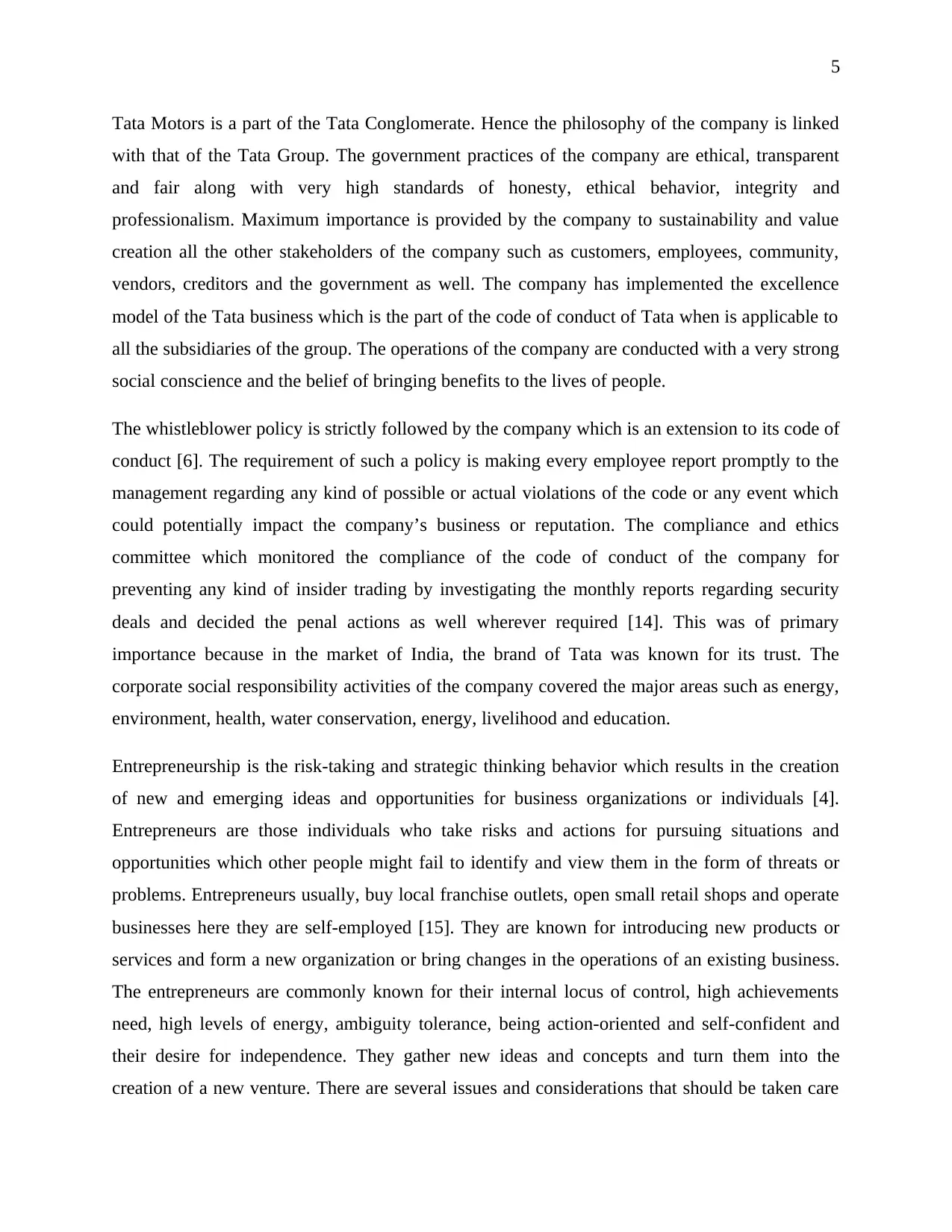
5
Tata Motors is a part of the Tata Conglomerate. Hence the philosophy of the company is linked
with that of the Tata Group. The government practices of the company are ethical, transparent
and fair along with very high standards of honesty, ethical behavior, integrity and
professionalism. Maximum importance is provided by the company to sustainability and value
creation all the other stakeholders of the company such as customers, employees, community,
vendors, creditors and the government as well. The company has implemented the excellence
model of the Tata business which is the part of the code of conduct of Tata when is applicable to
all the subsidiaries of the group. The operations of the company are conducted with a very strong
social conscience and the belief of bringing benefits to the lives of people.
The whistleblower policy is strictly followed by the company which is an extension to its code of
conduct [6]. The requirement of such a policy is making every employee report promptly to the
management regarding any kind of possible or actual violations of the code or any event which
could potentially impact the company’s business or reputation. The compliance and ethics
committee which monitored the compliance of the code of conduct of the company for
preventing any kind of insider trading by investigating the monthly reports regarding security
deals and decided the penal actions as well wherever required [14]. This was of primary
importance because in the market of India, the brand of Tata was known for its trust. The
corporate social responsibility activities of the company covered the major areas such as energy,
environment, health, water conservation, energy, livelihood and education.
Entrepreneurship is the risk-taking and strategic thinking behavior which results in the creation
of new and emerging ideas and opportunities for business organizations or individuals [4].
Entrepreneurs are those individuals who take risks and actions for pursuing situations and
opportunities which other people might fail to identify and view them in the form of threats or
problems. Entrepreneurs usually, buy local franchise outlets, open small retail shops and operate
businesses here they are self-employed [15]. They are known for introducing new products or
services and form a new organization or bring changes in the operations of an existing business.
The entrepreneurs are commonly known for their internal locus of control, high achievements
need, high levels of energy, ambiguity tolerance, being action-oriented and self-confident and
their desire for independence. They gather new ideas and concepts and turn them into the
creation of a new venture. There are several issues and considerations that should be taken care
Tata Motors is a part of the Tata Conglomerate. Hence the philosophy of the company is linked
with that of the Tata Group. The government practices of the company are ethical, transparent
and fair along with very high standards of honesty, ethical behavior, integrity and
professionalism. Maximum importance is provided by the company to sustainability and value
creation all the other stakeholders of the company such as customers, employees, community,
vendors, creditors and the government as well. The company has implemented the excellence
model of the Tata business which is the part of the code of conduct of Tata when is applicable to
all the subsidiaries of the group. The operations of the company are conducted with a very strong
social conscience and the belief of bringing benefits to the lives of people.
The whistleblower policy is strictly followed by the company which is an extension to its code of
conduct [6]. The requirement of such a policy is making every employee report promptly to the
management regarding any kind of possible or actual violations of the code or any event which
could potentially impact the company’s business or reputation. The compliance and ethics
committee which monitored the compliance of the code of conduct of the company for
preventing any kind of insider trading by investigating the monthly reports regarding security
deals and decided the penal actions as well wherever required [14]. This was of primary
importance because in the market of India, the brand of Tata was known for its trust. The
corporate social responsibility activities of the company covered the major areas such as energy,
environment, health, water conservation, energy, livelihood and education.
Entrepreneurship is the risk-taking and strategic thinking behavior which results in the creation
of new and emerging ideas and opportunities for business organizations or individuals [4].
Entrepreneurs are those individuals who take risks and actions for pursuing situations and
opportunities which other people might fail to identify and view them in the form of threats or
problems. Entrepreneurs usually, buy local franchise outlets, open small retail shops and operate
businesses here they are self-employed [15]. They are known for introducing new products or
services and form a new organization or bring changes in the operations of an existing business.
The entrepreneurs are commonly known for their internal locus of control, high achievements
need, high levels of energy, ambiguity tolerance, being action-oriented and self-confident and
their desire for independence. They gather new ideas and concepts and turn them into the
creation of a new venture. There are several issues and considerations that should be taken care
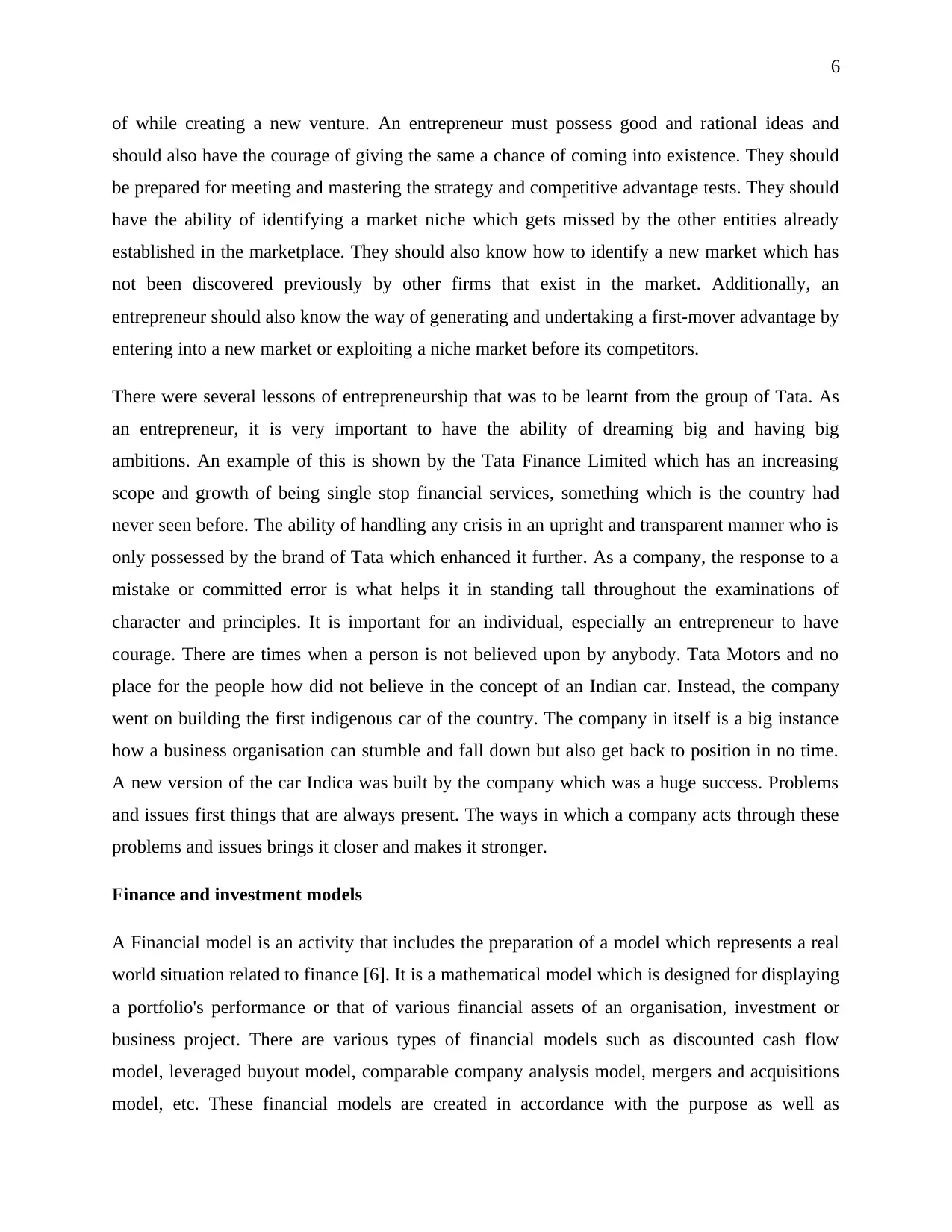
6
of while creating a new venture. An entrepreneur must possess good and rational ideas and
should also have the courage of giving the same a chance of coming into existence. They should
be prepared for meeting and mastering the strategy and competitive advantage tests. They should
have the ability of identifying a market niche which gets missed by the other entities already
established in the marketplace. They should also know how to identify a new market which has
not been discovered previously by other firms that exist in the market. Additionally, an
entrepreneur should also know the way of generating and undertaking a first-mover advantage by
entering into a new market or exploiting a niche market before its competitors.
There were several lessons of entrepreneurship that was to be learnt from the group of Tata. As
an entrepreneur, it is very important to have the ability of dreaming big and having big
ambitions. An example of this is shown by the Tata Finance Limited which has an increasing
scope and growth of being single stop financial services, something which is the country had
never seen before. The ability of handling any crisis in an upright and transparent manner who is
only possessed by the brand of Tata which enhanced it further. As a company, the response to a
mistake or committed error is what helps it in standing tall throughout the examinations of
character and principles. It is important for an individual, especially an entrepreneur to have
courage. There are times when a person is not believed upon by anybody. Tata Motors and no
place for the people how did not believe in the concept of an Indian car. Instead, the company
went on building the first indigenous car of the country. The company in itself is a big instance
how a business organisation can stumble and fall down but also get back to position in no time.
A new version of the car Indica was built by the company which was a huge success. Problems
and issues first things that are always present. The ways in which a company acts through these
problems and issues brings it closer and makes it stronger.
Finance and investment models
A Financial model is an activity that includes the preparation of a model which represents a real
world situation related to finance [6]. It is a mathematical model which is designed for displaying
a portfolio's performance or that of various financial assets of an organisation, investment or
business project. There are various types of financial models such as discounted cash flow
model, leveraged buyout model, comparable company analysis model, mergers and acquisitions
model, etc. These financial models are created in accordance with the purpose as well as
of while creating a new venture. An entrepreneur must possess good and rational ideas and
should also have the courage of giving the same a chance of coming into existence. They should
be prepared for meeting and mastering the strategy and competitive advantage tests. They should
have the ability of identifying a market niche which gets missed by the other entities already
established in the marketplace. They should also know how to identify a new market which has
not been discovered previously by other firms that exist in the market. Additionally, an
entrepreneur should also know the way of generating and undertaking a first-mover advantage by
entering into a new market or exploiting a niche market before its competitors.
There were several lessons of entrepreneurship that was to be learnt from the group of Tata. As
an entrepreneur, it is very important to have the ability of dreaming big and having big
ambitions. An example of this is shown by the Tata Finance Limited which has an increasing
scope and growth of being single stop financial services, something which is the country had
never seen before. The ability of handling any crisis in an upright and transparent manner who is
only possessed by the brand of Tata which enhanced it further. As a company, the response to a
mistake or committed error is what helps it in standing tall throughout the examinations of
character and principles. It is important for an individual, especially an entrepreneur to have
courage. There are times when a person is not believed upon by anybody. Tata Motors and no
place for the people how did not believe in the concept of an Indian car. Instead, the company
went on building the first indigenous car of the country. The company in itself is a big instance
how a business organisation can stumble and fall down but also get back to position in no time.
A new version of the car Indica was built by the company which was a huge success. Problems
and issues first things that are always present. The ways in which a company acts through these
problems and issues brings it closer and makes it stronger.
Finance and investment models
A Financial model is an activity that includes the preparation of a model which represents a real
world situation related to finance [6]. It is a mathematical model which is designed for displaying
a portfolio's performance or that of various financial assets of an organisation, investment or
business project. There are various types of financial models such as discounted cash flow
model, leveraged buyout model, comparable company analysis model, mergers and acquisitions
model, etc. These financial models are created in accordance with the purpose as well as
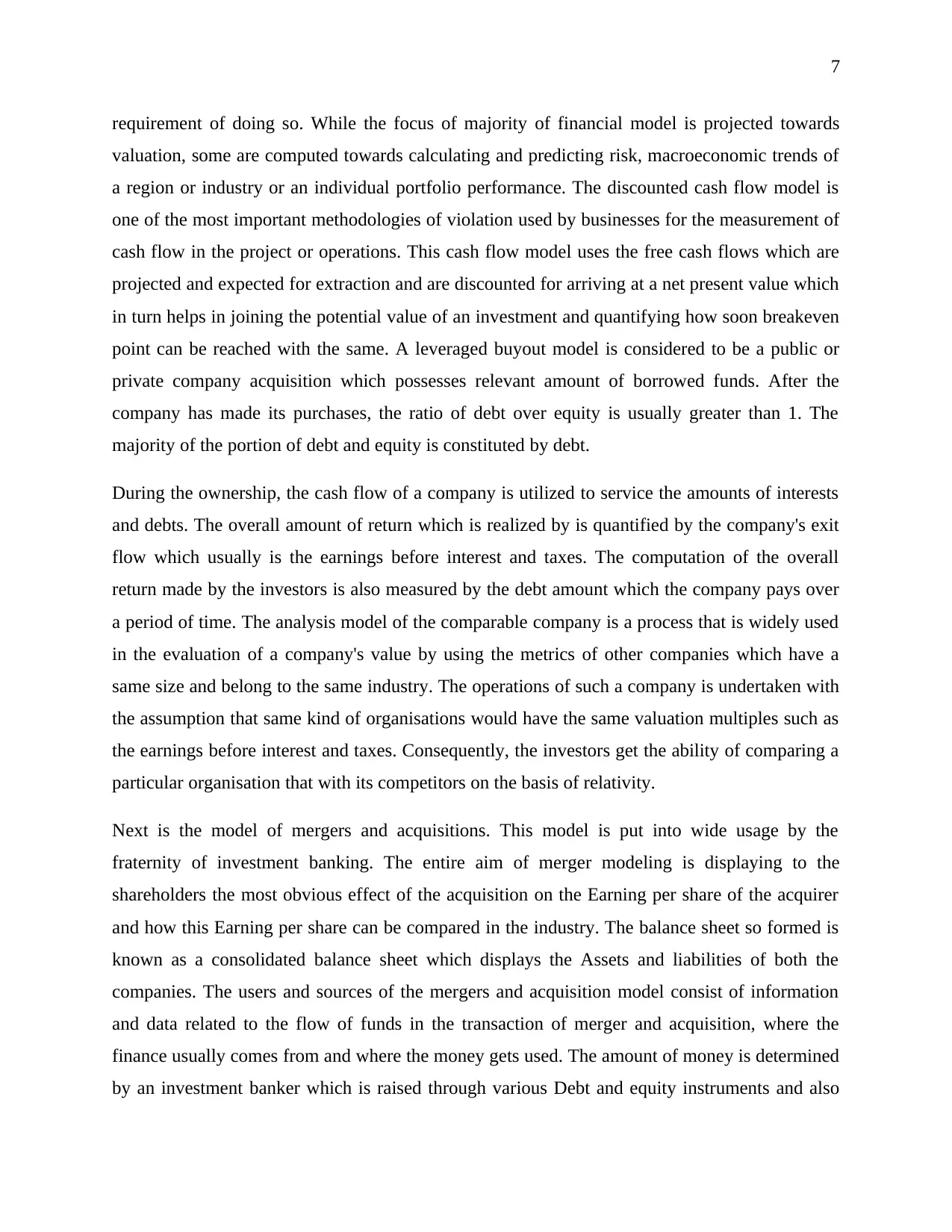
7
requirement of doing so. While the focus of majority of financial model is projected towards
valuation, some are computed towards calculating and predicting risk, macroeconomic trends of
a region or industry or an individual portfolio performance. The discounted cash flow model is
one of the most important methodologies of violation used by businesses for the measurement of
cash flow in the project or operations. This cash flow model uses the free cash flows which are
projected and expected for extraction and are discounted for arriving at a net present value which
in turn helps in joining the potential value of an investment and quantifying how soon breakeven
point can be reached with the same. A leveraged buyout model is considered to be a public or
private company acquisition which possesses relevant amount of borrowed funds. After the
company has made its purchases, the ratio of debt over equity is usually greater than 1. The
majority of the portion of debt and equity is constituted by debt.
During the ownership, the cash flow of a company is utilized to service the amounts of interests
and debts. The overall amount of return which is realized by is quantified by the company's exit
flow which usually is the earnings before interest and taxes. The computation of the overall
return made by the investors is also measured by the debt amount which the company pays over
a period of time. The analysis model of the comparable company is a process that is widely used
in the evaluation of a company's value by using the metrics of other companies which have a
same size and belong to the same industry. The operations of such a company is undertaken with
the assumption that same kind of organisations would have the same valuation multiples such as
the earnings before interest and taxes. Consequently, the investors get the ability of comparing a
particular organisation that with its competitors on the basis of relativity.
Next is the model of mergers and acquisitions. This model is put into wide usage by the
fraternity of investment banking. The entire aim of merger modeling is displaying to the
shareholders the most obvious effect of the acquisition on the Earning per share of the acquirer
and how this Earning per share can be compared in the industry. The balance sheet so formed is
known as a consolidated balance sheet which displays the Assets and liabilities of both the
companies. The users and sources of the mergers and acquisition model consist of information
and data related to the flow of funds in the transaction of merger and acquisition, where the
finance usually comes from and where the money gets used. The amount of money is determined
by an investment banker which is raised through various Debt and equity instruments and also
requirement of doing so. While the focus of majority of financial model is projected towards
valuation, some are computed towards calculating and predicting risk, macroeconomic trends of
a region or industry or an individual portfolio performance. The discounted cash flow model is
one of the most important methodologies of violation used by businesses for the measurement of
cash flow in the project or operations. This cash flow model uses the free cash flows which are
projected and expected for extraction and are discounted for arriving at a net present value which
in turn helps in joining the potential value of an investment and quantifying how soon breakeven
point can be reached with the same. A leveraged buyout model is considered to be a public or
private company acquisition which possesses relevant amount of borrowed funds. After the
company has made its purchases, the ratio of debt over equity is usually greater than 1. The
majority of the portion of debt and equity is constituted by debt.
During the ownership, the cash flow of a company is utilized to service the amounts of interests
and debts. The overall amount of return which is realized by is quantified by the company's exit
flow which usually is the earnings before interest and taxes. The computation of the overall
return made by the investors is also measured by the debt amount which the company pays over
a period of time. The analysis model of the comparable company is a process that is widely used
in the evaluation of a company's value by using the metrics of other companies which have a
same size and belong to the same industry. The operations of such a company is undertaken with
the assumption that same kind of organisations would have the same valuation multiples such as
the earnings before interest and taxes. Consequently, the investors get the ability of comparing a
particular organisation that with its competitors on the basis of relativity.
Next is the model of mergers and acquisitions. This model is put into wide usage by the
fraternity of investment banking. The entire aim of merger modeling is displaying to the
shareholders the most obvious effect of the acquisition on the Earning per share of the acquirer
and how this Earning per share can be compared in the industry. The balance sheet so formed is
known as a consolidated balance sheet which displays the Assets and liabilities of both the
companies. The users and sources of the mergers and acquisition model consist of information
and data related to the flow of funds in the transaction of merger and acquisition, where the
finance usually comes from and where the money gets used. The amount of money is determined
by an investment banker which is raised through various Debt and equity instruments and also
Paraphrase This Document
Need a fresh take? Get an instant paraphrase of this document with our AI Paraphraser
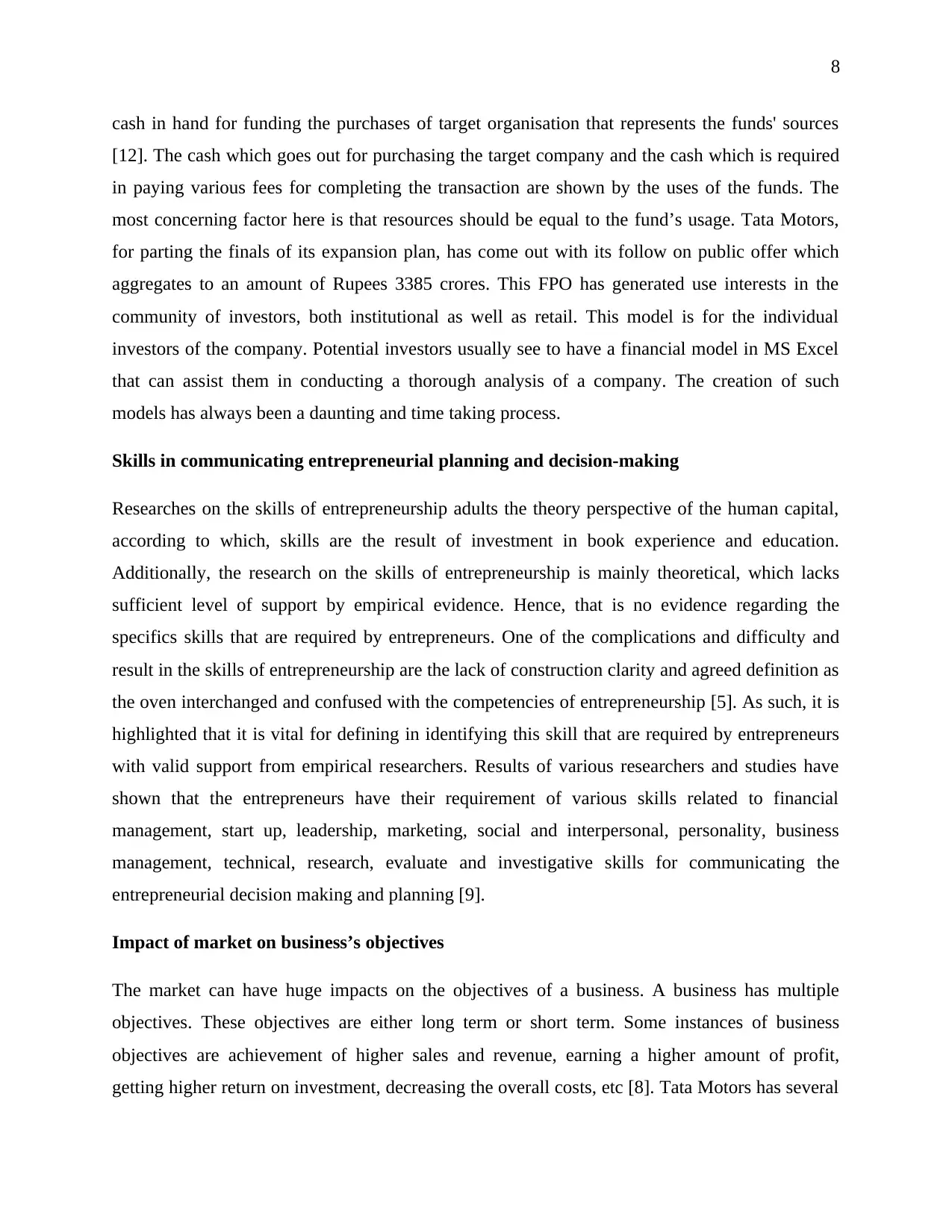
8
cash in hand for funding the purchases of target organisation that represents the funds' sources
[12]. The cash which goes out for purchasing the target company and the cash which is required
in paying various fees for completing the transaction are shown by the uses of the funds. The
most concerning factor here is that resources should be equal to the fund’s usage. Tata Motors,
for parting the finals of its expansion plan, has come out with its follow on public offer which
aggregates to an amount of Rupees 3385 crores. This FPO has generated use interests in the
community of investors, both institutional as well as retail. This model is for the individual
investors of the company. Potential investors usually see to have a financial model in MS Excel
that can assist them in conducting a thorough analysis of a company. The creation of such
models has always been a daunting and time taking process.
Skills in communicating entrepreneurial planning and decision-making
Researches on the skills of entrepreneurship adults the theory perspective of the human capital,
according to which, skills are the result of investment in book experience and education.
Additionally, the research on the skills of entrepreneurship is mainly theoretical, which lacks
sufficient level of support by empirical evidence. Hence, that is no evidence regarding the
specifics skills that are required by entrepreneurs. One of the complications and difficulty and
result in the skills of entrepreneurship are the lack of construction clarity and agreed definition as
the oven interchanged and confused with the competencies of entrepreneurship [5]. As such, it is
highlighted that it is vital for defining in identifying this skill that are required by entrepreneurs
with valid support from empirical researchers. Results of various researchers and studies have
shown that the entrepreneurs have their requirement of various skills related to financial
management, start up, leadership, marketing, social and interpersonal, personality, business
management, technical, research, evaluate and investigative skills for communicating the
entrepreneurial decision making and planning [9].
Impact of market on business’s objectives
The market can have huge impacts on the objectives of a business. A business has multiple
objectives. These objectives are either long term or short term. Some instances of business
objectives are achievement of higher sales and revenue, earning a higher amount of profit,
getting higher return on investment, decreasing the overall costs, etc [8]. Tata Motors has several
cash in hand for funding the purchases of target organisation that represents the funds' sources
[12]. The cash which goes out for purchasing the target company and the cash which is required
in paying various fees for completing the transaction are shown by the uses of the funds. The
most concerning factor here is that resources should be equal to the fund’s usage. Tata Motors,
for parting the finals of its expansion plan, has come out with its follow on public offer which
aggregates to an amount of Rupees 3385 crores. This FPO has generated use interests in the
community of investors, both institutional as well as retail. This model is for the individual
investors of the company. Potential investors usually see to have a financial model in MS Excel
that can assist them in conducting a thorough analysis of a company. The creation of such
models has always been a daunting and time taking process.
Skills in communicating entrepreneurial planning and decision-making
Researches on the skills of entrepreneurship adults the theory perspective of the human capital,
according to which, skills are the result of investment in book experience and education.
Additionally, the research on the skills of entrepreneurship is mainly theoretical, which lacks
sufficient level of support by empirical evidence. Hence, that is no evidence regarding the
specifics skills that are required by entrepreneurs. One of the complications and difficulty and
result in the skills of entrepreneurship are the lack of construction clarity and agreed definition as
the oven interchanged and confused with the competencies of entrepreneurship [5]. As such, it is
highlighted that it is vital for defining in identifying this skill that are required by entrepreneurs
with valid support from empirical researchers. Results of various researchers and studies have
shown that the entrepreneurs have their requirement of various skills related to financial
management, start up, leadership, marketing, social and interpersonal, personality, business
management, technical, research, evaluate and investigative skills for communicating the
entrepreneurial decision making and planning [9].
Impact of market on business’s objectives
The market can have huge impacts on the objectives of a business. A business has multiple
objectives. These objectives are either long term or short term. Some instances of business
objectives are achievement of higher sales and revenue, earning a higher amount of profit,
getting higher return on investment, decreasing the overall costs, etc [8]. Tata Motors has several
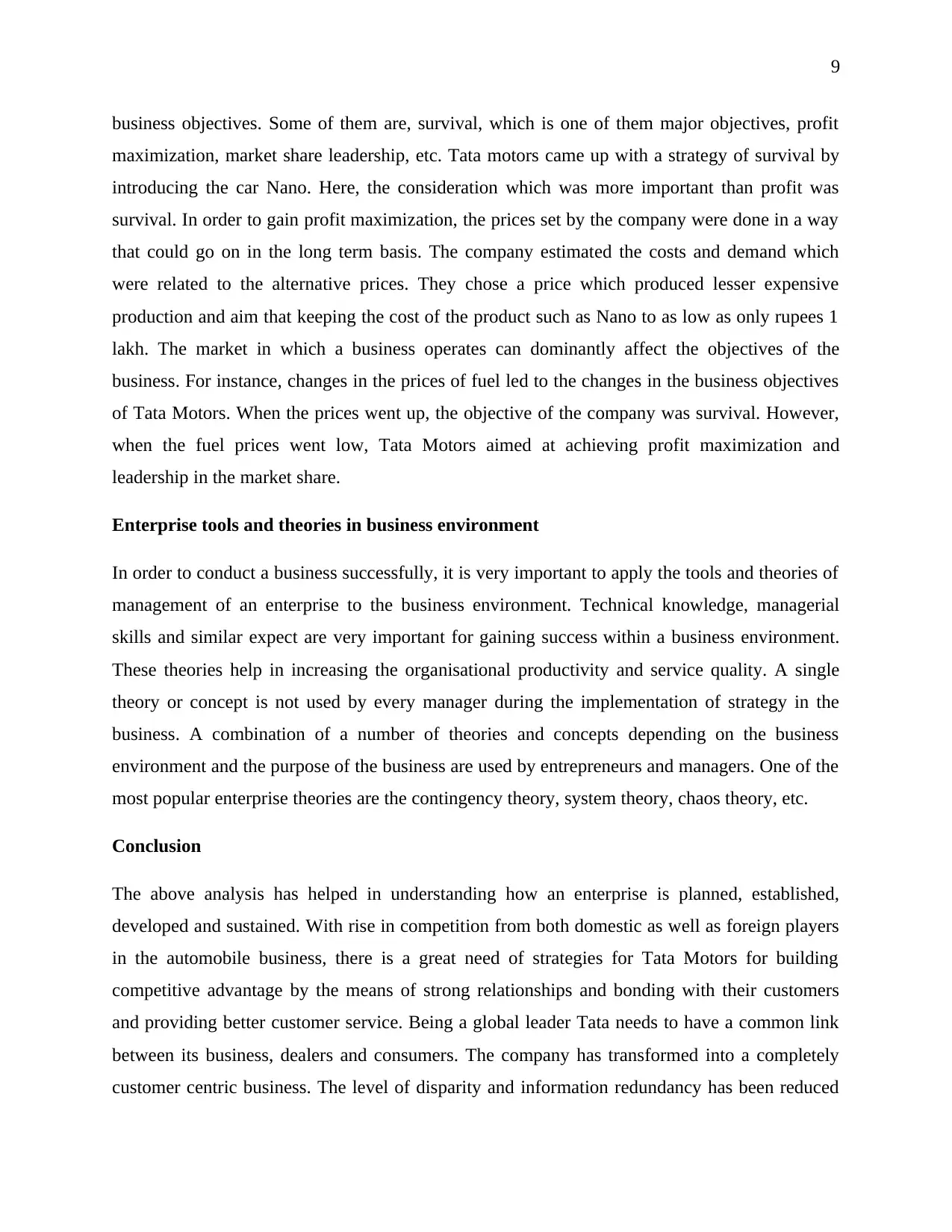
9
business objectives. Some of them are, survival, which is one of them major objectives, profit
maximization, market share leadership, etc. Tata motors came up with a strategy of survival by
introducing the car Nano. Here, the consideration which was more important than profit was
survival. In order to gain profit maximization, the prices set by the company were done in a way
that could go on in the long term basis. The company estimated the costs and demand which
were related to the alternative prices. They chose a price which produced lesser expensive
production and aim that keeping the cost of the product such as Nano to as low as only rupees 1
lakh. The market in which a business operates can dominantly affect the objectives of the
business. For instance, changes in the prices of fuel led to the changes in the business objectives
of Tata Motors. When the prices went up, the objective of the company was survival. However,
when the fuel prices went low, Tata Motors aimed at achieving profit maximization and
leadership in the market share.
Enterprise tools and theories in business environment
In order to conduct a business successfully, it is very important to apply the tools and theories of
management of an enterprise to the business environment. Technical knowledge, managerial
skills and similar expect are very important for gaining success within a business environment.
These theories help in increasing the organisational productivity and service quality. A single
theory or concept is not used by every manager during the implementation of strategy in the
business. A combination of a number of theories and concepts depending on the business
environment and the purpose of the business are used by entrepreneurs and managers. One of the
most popular enterprise theories are the contingency theory, system theory, chaos theory, etc.
Conclusion
The above analysis has helped in understanding how an enterprise is planned, established,
developed and sustained. With rise in competition from both domestic as well as foreign players
in the automobile business, there is a great need of strategies for Tata Motors for building
competitive advantage by the means of strong relationships and bonding with their customers
and providing better customer service. Being a global leader Tata needs to have a common link
between its business, dealers and consumers. The company has transformed into a completely
customer centric business. The level of disparity and information redundancy has been reduced
business objectives. Some of them are, survival, which is one of them major objectives, profit
maximization, market share leadership, etc. Tata motors came up with a strategy of survival by
introducing the car Nano. Here, the consideration which was more important than profit was
survival. In order to gain profit maximization, the prices set by the company were done in a way
that could go on in the long term basis. The company estimated the costs and demand which
were related to the alternative prices. They chose a price which produced lesser expensive
production and aim that keeping the cost of the product such as Nano to as low as only rupees 1
lakh. The market in which a business operates can dominantly affect the objectives of the
business. For instance, changes in the prices of fuel led to the changes in the business objectives
of Tata Motors. When the prices went up, the objective of the company was survival. However,
when the fuel prices went low, Tata Motors aimed at achieving profit maximization and
leadership in the market share.
Enterprise tools and theories in business environment
In order to conduct a business successfully, it is very important to apply the tools and theories of
management of an enterprise to the business environment. Technical knowledge, managerial
skills and similar expect are very important for gaining success within a business environment.
These theories help in increasing the organisational productivity and service quality. A single
theory or concept is not used by every manager during the implementation of strategy in the
business. A combination of a number of theories and concepts depending on the business
environment and the purpose of the business are used by entrepreneurs and managers. One of the
most popular enterprise theories are the contingency theory, system theory, chaos theory, etc.
Conclusion
The above analysis has helped in understanding how an enterprise is planned, established,
developed and sustained. With rise in competition from both domestic as well as foreign players
in the automobile business, there is a great need of strategies for Tata Motors for building
competitive advantage by the means of strong relationships and bonding with their customers
and providing better customer service. Being a global leader Tata needs to have a common link
between its business, dealers and consumers. The company has transformed into a completely
customer centric business. The level of disparity and information redundancy has been reduced
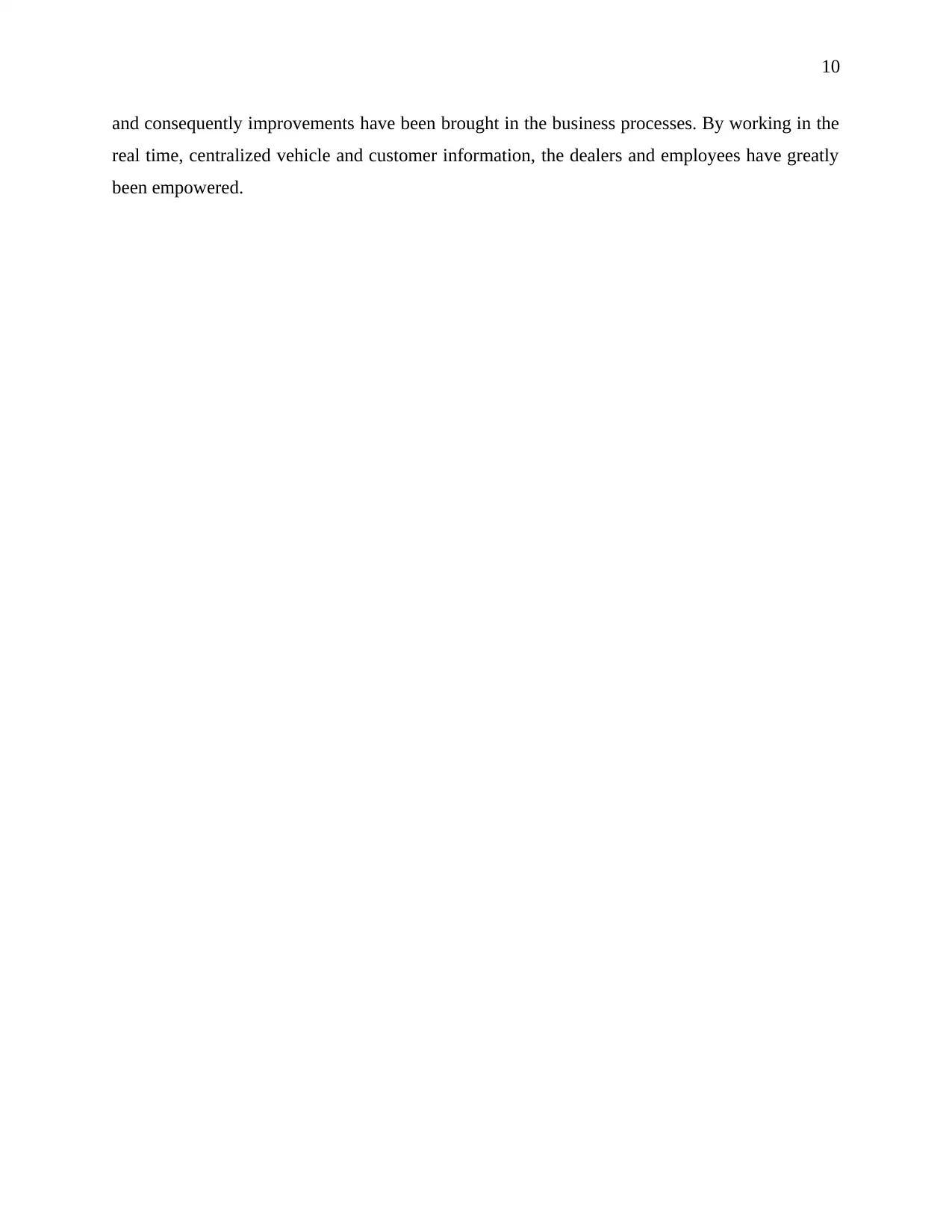
10
and consequently improvements have been brought in the business processes. By working in the
real time, centralized vehicle and customer information, the dealers and employees have greatly
been empowered.
and consequently improvements have been brought in the business processes. By working in the
real time, centralized vehicle and customer information, the dealers and employees have greatly
been empowered.
Secure Best Marks with AI Grader
Need help grading? Try our AI Grader for instant feedback on your assignments.
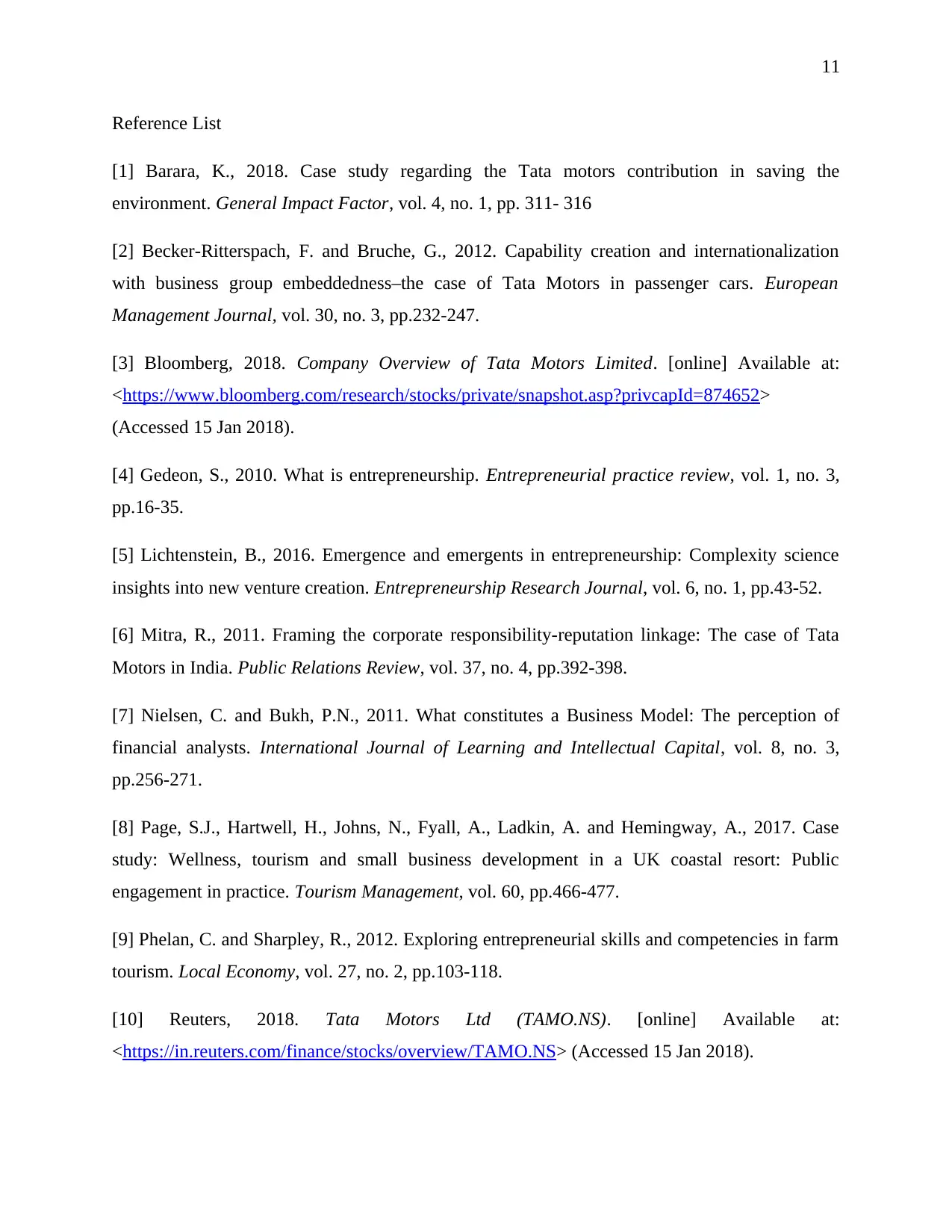
11
Reference List
[1] Barara, K., 2018. Case study regarding the Tata motors contribution in saving the
environment. General Impact Factor, vol. 4, no. 1, pp. 311- 316
[2] Becker-Ritterspach, F. and Bruche, G., 2012. Capability creation and internationalization
with business group embeddedness–the case of Tata Motors in passenger cars. European
Management Journal, vol. 30, no. 3, pp.232-247.
[3] Bloomberg, 2018. Company Overview of Tata Motors Limited. [online] Available at:
<https://www.bloomberg.com/research/stocks/private/snapshot.asp?privcapId=874652>
(Accessed 15 Jan 2018).
[4] Gedeon, S., 2010. What is entrepreneurship. Entrepreneurial practice review, vol. 1, no. 3,
pp.16-35.
[5] Lichtenstein, B., 2016. Emergence and emergents in entrepreneurship: Complexity science
insights into new venture creation. Entrepreneurship Research Journal, vol. 6, no. 1, pp.43-52.
[6] Mitra, R., 2011. Framing the corporate responsibility-reputation linkage: The case of Tata
Motors in India. Public Relations Review, vol. 37, no. 4, pp.392-398.
[7] Nielsen, C. and Bukh, P.N., 2011. What constitutes a Business Model: The perception of
financial analysts. International Journal of Learning and Intellectual Capital, vol. 8, no. 3,
pp.256-271.
[8] Page, S.J., Hartwell, H., Johns, N., Fyall, A., Ladkin, A. and Hemingway, A., 2017. Case
study: Wellness, tourism and small business development in a UK coastal resort: Public
engagement in practice. Tourism Management, vol. 60, pp.466-477.
[9] Phelan, C. and Sharpley, R., 2012. Exploring entrepreneurial skills and competencies in farm
tourism. Local Economy, vol. 27, no. 2, pp.103-118.
[10] Reuters, 2018. Tata Motors Ltd (TAMO.NS). [online] Available at:
<https://in.reuters.com/finance/stocks/overview/TAMO.NS> (Accessed 15 Jan 2018).
Reference List
[1] Barara, K., 2018. Case study regarding the Tata motors contribution in saving the
environment. General Impact Factor, vol. 4, no. 1, pp. 311- 316
[2] Becker-Ritterspach, F. and Bruche, G., 2012. Capability creation and internationalization
with business group embeddedness–the case of Tata Motors in passenger cars. European
Management Journal, vol. 30, no. 3, pp.232-247.
[3] Bloomberg, 2018. Company Overview of Tata Motors Limited. [online] Available at:
<https://www.bloomberg.com/research/stocks/private/snapshot.asp?privcapId=874652>
(Accessed 15 Jan 2018).
[4] Gedeon, S., 2010. What is entrepreneurship. Entrepreneurial practice review, vol. 1, no. 3,
pp.16-35.
[5] Lichtenstein, B., 2016. Emergence and emergents in entrepreneurship: Complexity science
insights into new venture creation. Entrepreneurship Research Journal, vol. 6, no. 1, pp.43-52.
[6] Mitra, R., 2011. Framing the corporate responsibility-reputation linkage: The case of Tata
Motors in India. Public Relations Review, vol. 37, no. 4, pp.392-398.
[7] Nielsen, C. and Bukh, P.N., 2011. What constitutes a Business Model: The perception of
financial analysts. International Journal of Learning and Intellectual Capital, vol. 8, no. 3,
pp.256-271.
[8] Page, S.J., Hartwell, H., Johns, N., Fyall, A., Ladkin, A. and Hemingway, A., 2017. Case
study: Wellness, tourism and small business development in a UK coastal resort: Public
engagement in practice. Tourism Management, vol. 60, pp.466-477.
[9] Phelan, C. and Sharpley, R., 2012. Exploring entrepreneurial skills and competencies in farm
tourism. Local Economy, vol. 27, no. 2, pp.103-118.
[10] Reuters, 2018. Tata Motors Ltd (TAMO.NS). [online] Available at:
<https://in.reuters.com/finance/stocks/overview/TAMO.NS> (Accessed 15 Jan 2018).
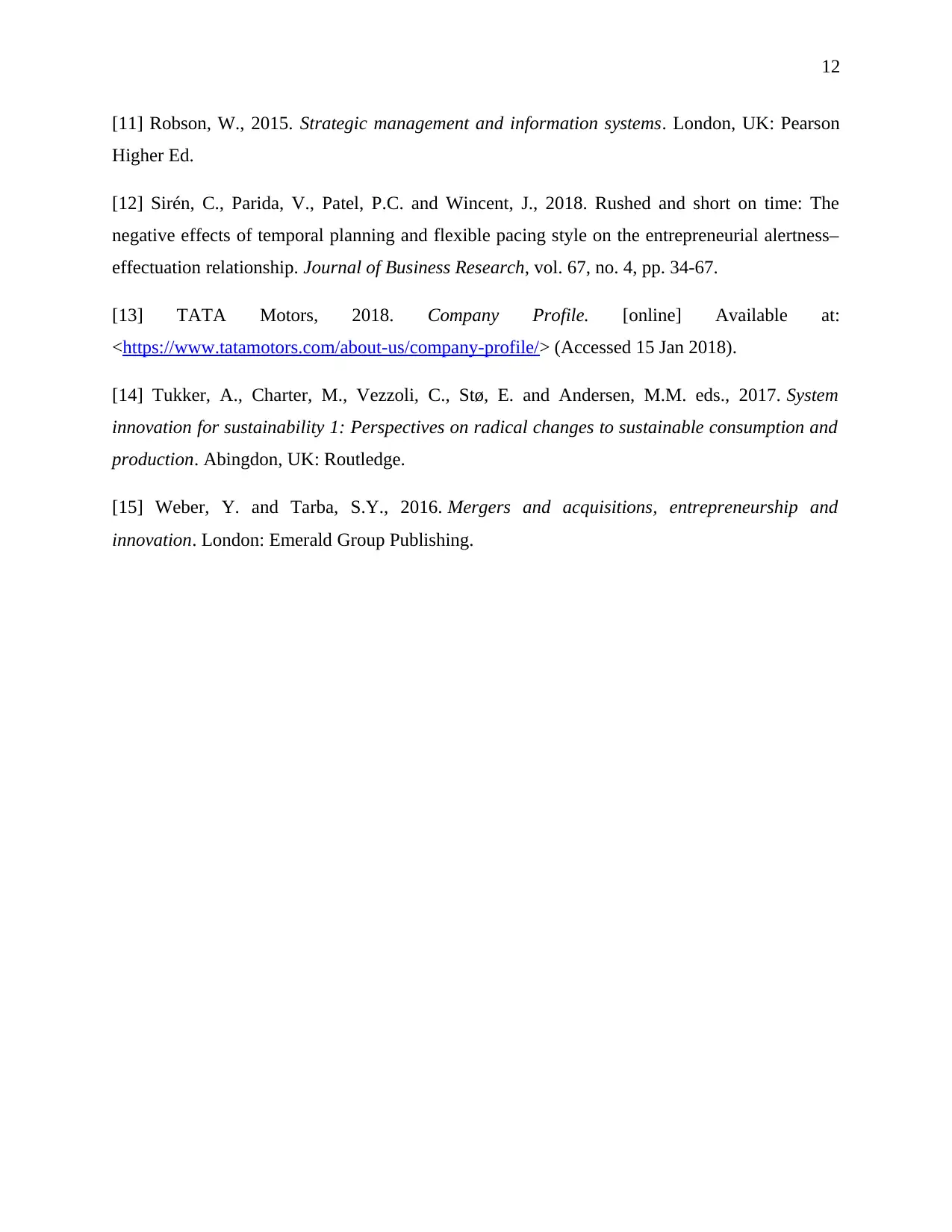
12
[11] Robson, W., 2015. Strategic management and information systems. London, UK: Pearson
Higher Ed.
[12] Sirén, C., Parida, V., Patel, P.C. and Wincent, J., 2018. Rushed and short on time: The
negative effects of temporal planning and flexible pacing style on the entrepreneurial alertness–
effectuation relationship. Journal of Business Research, vol. 67, no. 4, pp. 34-67.
[13] TATA Motors, 2018. Company Profile. [online] Available at:
<https://www.tatamotors.com/about-us/company-profile/> (Accessed 15 Jan 2018).
[14] Tukker, A., Charter, M., Vezzoli, C., Stø, E. and Andersen, M.M. eds., 2017. System
innovation for sustainability 1: Perspectives on radical changes to sustainable consumption and
production. Abingdon, UK: Routledge.
[15] Weber, Y. and Tarba, S.Y., 2016. Mergers and acquisitions, entrepreneurship and
innovation. London: Emerald Group Publishing.
[11] Robson, W., 2015. Strategic management and information systems. London, UK: Pearson
Higher Ed.
[12] Sirén, C., Parida, V., Patel, P.C. and Wincent, J., 2018. Rushed and short on time: The
negative effects of temporal planning and flexible pacing style on the entrepreneurial alertness–
effectuation relationship. Journal of Business Research, vol. 67, no. 4, pp. 34-67.
[13] TATA Motors, 2018. Company Profile. [online] Available at:
<https://www.tatamotors.com/about-us/company-profile/> (Accessed 15 Jan 2018).
[14] Tukker, A., Charter, M., Vezzoli, C., Stø, E. and Andersen, M.M. eds., 2017. System
innovation for sustainability 1: Perspectives on radical changes to sustainable consumption and
production. Abingdon, UK: Routledge.
[15] Weber, Y. and Tarba, S.Y., 2016. Mergers and acquisitions, entrepreneurship and
innovation. London: Emerald Group Publishing.
1 out of 12
Related Documents
Your All-in-One AI-Powered Toolkit for Academic Success.
+13062052269
info@desklib.com
Available 24*7 on WhatsApp / Email
![[object Object]](/_next/static/media/star-bottom.7253800d.svg)
Unlock your academic potential
© 2024 | Zucol Services PVT LTD | All rights reserved.





